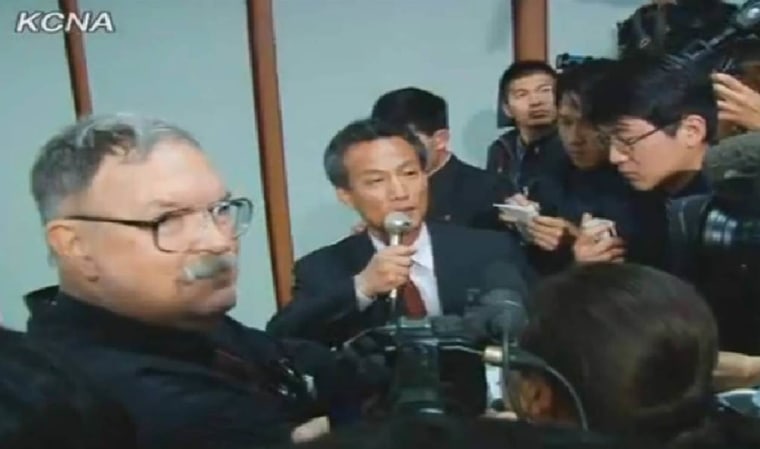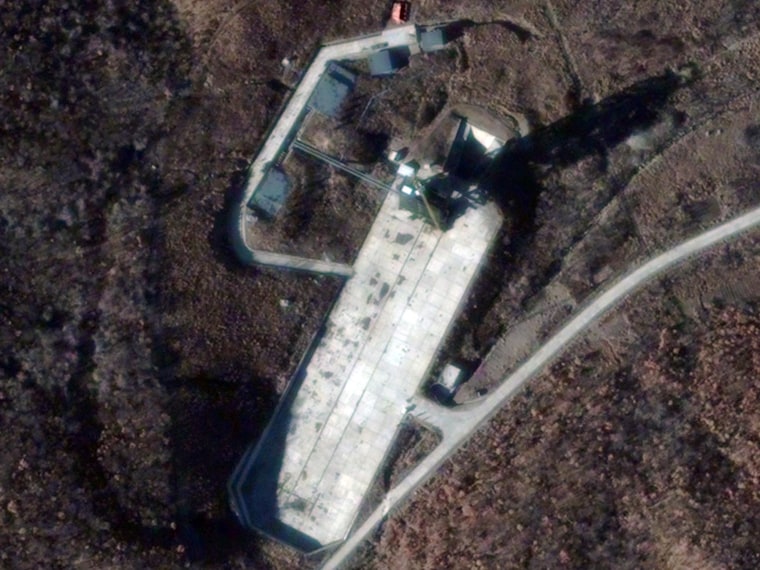North Korea has two things to prove to the world when it tries once again to put a satellite into orbit, as announced over the weekend. First, engineers have to prove that they've solved the technical problems that led to an embarrassing launch failure in April. Second, officials have to prove that their intentions are as peaceful as they say they are.
As hard as the first challenge is, the second one may be harder.
Some observers have referred to this month's scheduled launch as a test for a long-range missile capable of hitting the United States, but this weekend's statement from Pyongyang was explicit: The North Koreans say they are simply trying again to put a satellite into orbit.
The mission has been portrayed as a do-over for April's launch of the Unha rocket and Kwangmyongsong satellite. The launch will once again take place at the Sohae Satellite Launch Station, where our NBC News team and other foreign journalists were given a pre-launch tour. Once again, the rocket is due to fly almost due south, putting the satellite in a polar orbit, according to warnings posted for fliers and mariners in the projected impact zone.
This time, however, the North Koreans are hoping to avoid premature impact. In April, the first stage of the three-stage Unha rocket disintegrated near the end of its two-minute thrusting phase, with the debris plunging into shallow waters west of the South Korean coastline.
Good news, bad news
From the North Koreans' perspective, the good news is that the first stage worked properly on at least two earlier launches, where upper stages then failed. So the design is probably fixable.
But clues as to the nature of the failure have been scanty. Any debris that was recovered is probably in South Korean (and perhaps U.S.) hands. The available telemetry about the rocket's operating parameters probably was not extensive.
The bad news is that North Korean engineers have had to struggle against a top-down obedience culture that probably led to the previous failures. Over the decades, space workers in the West and in Russia have learned a bitter lesson about spaceflight: that all engineers need to be empowered to say "wait" if they detect something not quite right. But when I met with the North Korean space program's leaders in April, that concept seemed alien to them.
Clues to April's disaster
The flight path might contain one clue, since the disintegration seemed to occur just past the point of maximum aerodynamic pressure on the rocket. Buffeting increases rapidly with speed, but also drops off as air thickness diminishes. There is a point where it is most severe, and a large number of bad things can happen in this phase.
But there were worse pressures than the aerodynamic ones. The North Korean space team had been ordered to launch on a political schedule, with overtly ideological overtones. In such an environment, small errors can slip by, unflagged, by fearful workers hoping for the best. We can't tell from here the degree to which such a pervasive attitude allowed flaws to remain unfixed. The problem may be that the North Koreans can't, either.
I saw no indications from the interviews and discussions in April that they were even aware of the potential for problems. Everything else in their culture obeys the commands of the Great Leader — so why shouldn't rockets, too?
That attitude explains the absolutely blank astonishment with which our escorts responded to the news, relayed to us by colleagues overseas, that the April 13 launch had occurred, and quickly failed. We might as well have told them that space aliens had taken over all the world's capitals, or that the dead had risen and zombie armies were on the march. They were wide-eyed with the inability to form a rational response.
From the moment the rocket had been launched — in secret, despite a repeated promise that we would be allowed to "observe" the liftoff — none of the North Koreans dealing with us ever mentioned it again. They didn't even acknowledge to us that it had failed.
It was as if somebody had zapped them all with some little flashy thing that erased all memory of us ever being invited to observe the rocket. Rocket? What rocket? Surely we were all here for their centenary celebration of Kim Il Sung's birth!
Can they prove peacefulness?
And that raises the second critical unknown that needs repair. Can the North Koreans really demonstrate what they had invited us in for last April: that the aim of the launch is merely to put a peaceful satellite into orbit, with no military significance.

In April, our hosts showed us a lot of stuff — but nothing really critical to the issue of military versus civilian use. They showed us what they said was a satellite to be carried by the rocket, which they also showed us. But they never showed us the satellite being transported to the launch pad and mounted on the rocket. They never even showed pictures or video of that process, or what really was under the nose cone when the rocket lifted off. When challenged directly, they promised to do so. Then they showed us nothing.
The nose cone was large enough to have carried other small objects besides the satellite, and the most worrisome alternative payload was a "re-entry vehicle," or RV. This is the heat-shielded capsule necessary to let a warhead survive the fiery return into the atmosphere on its way to its target.
The presence of an RV is also the unambiguous signature of a weaponized rocket. So if that actually were the secret purpose of the entire rocket program, disguising it — or even just adequately obscuring it — for as long as possible would be a major diplomatic goal.
The only real evidence for what was under the nose cone last April is indirect. Since the South Koreans and friends scoured the sea bottom where the rocket's fragments fell, surely they would have publicly revealed evidence that such a device had been found — even if only in fragments, assuming that a destruct charge was installed on the spacecraft.
Whom do you trust?
The North Koreans ended up providing no evidence that the satellite had been installed on the rocket, beyond their verbal assertions. But was there any other way to calibrate such assertions?
Some of the technical data we were given was legitimate. I had prepared some calibration tests of my own.
When I asked the Mission Control director how long it would be before the satellite's signals were first picked up in North Korea, he answered "about 11 hours." And because I had calculated that myself before leaving for North Korea, I knew the answer was correct.
Data screens we were shown at the Launch Control Center and the Mission Control Center omitted a lot of the plotted data, clearly for security reasons. But even without the ascent trajectory graph filled in, the display still had its X and Y axes fully labeled with actual numbers, which gave me confirmation of how high the initial launch leg would be. And a ground track plot showed the satellite passing across Antarctica with precise lat/long lines remaining. That provided precise information on the orbital inclination they were aiming for.
Other clues, however, suggested that the North Koreans were well-versed in deception. All of the space officials we met, from the escorts to the center directors, repeated the refrain that their first two satellites had successfully entered orbit. Nobody beyond the border of their own country believes that. Both rockets seem to have failed during the third stage of the ascent. Nothing was ever tracked in orbit, either by any national radar network or by worldwide private associations of visual and radio observers.
Yet when pressed, the officials refused to waver. They would reel off a list of alleged confirmations, that were known in the West as ambiguous clues that were later explained by other factors.
Finally, when pressed again by another journalist, the Mission Control director came up with a new explanation of why nobody else in the world had ever heard any radio signals that the satellites had allegedly been transmitting. To save power, he explained, the radio was turned on only over North Korea.
And then I knew for sure he was lying. Satellite signals aren't directed straight down at the land below, they are broadcast in all directions. Radio amateurs can pick them up via line-of-sight for thousands of kilometers in all directions — and via atmospheric ducting, sporadically all over the world.
The explanation was fiction. It was contrary to 50 years of experience with satellite signals.
Known unknowns
So the new launch has a twin set of challenges, one technological and one political.
Can they show they have fixed the original problem that crashed the launch in April? Can they provide unambiguous and credible evidence that there is no secret military test on this flight?
So far, I've seen no indication to give me any confidence that they have the proper attitudes to succeed at either goal.
Dispatches from April's North Korea rocket tour:
- What North Korea's rocket ruckus taught us
- How will North Korea cope with its rocket failure?
- James Oberg answers your questions about the launch
- Clues finally emerge about North Korea's launch center
- North Korea shows off its launch pad and satellite
- Q&A: Rocket is 'not a military missile ... but it's darn close'
- World News: NBC gets a rare peek inside North Korea
- Inside North Korea: Closely watched launch poses risks
NBC News space analyst James Oberg spent 22 years at NASA's Johnson Space Center as a Mission Control operator and an orbital designer. He is the author of several books on space history and space policy, including "Star-Crossed Orbits: Inside the U.S.-Russian Space Alliance."
